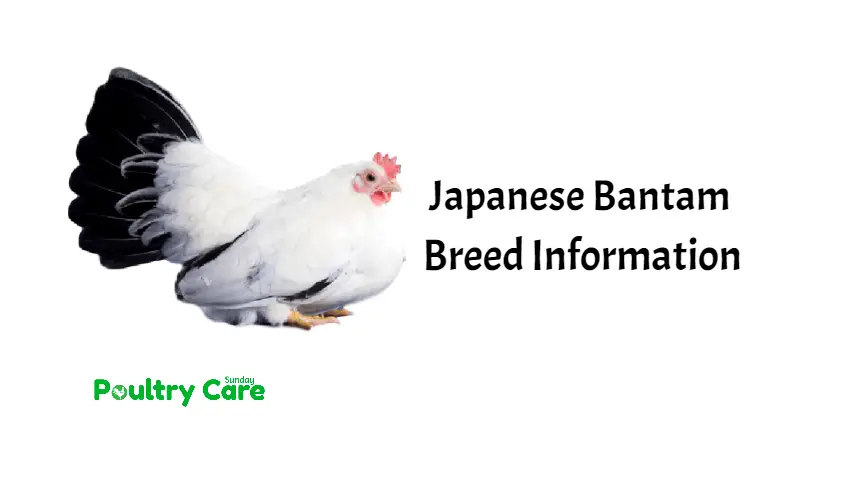Last Updated on April 27, 2022 by Pauline G. Carter
The Japanese Bantam chicken goes back years, probably as way back as the 7th Century. The Chabo Bantam as it was called then, is a Japanese fowl and was introduced in Europe sometime in the 16th Century. “Chabo” actually means little, bantam, miniature, dwarfish.
It lives up to that name because there aren’t any larger counterparts. In fact, it was never even bred as a standard-size chicken. It’s a true bantam. Today, the Japanese bantams are ornamental birds.
Poultry fanciers love this bird and have turned it into a very popular bird. According to the Association of American Bantams, Japanese Bantam Chickens are considered to be in the top 10 chicken breeds.
Japanese Bantam Chicken | Breed Profile
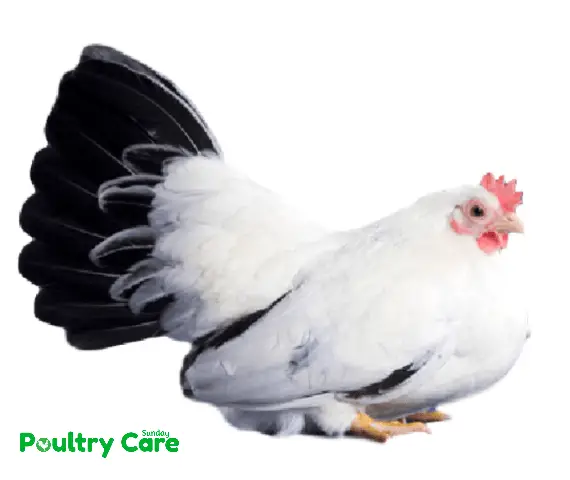
| Country of origin: | Japan |
| Primary use: | Exhibition / Ornamental |
| Weight: | Male: 510–600 g Female: 400–510 g |
| Temperament: | Hardy, Bit flighty |
| Recognized Varieties: | White, Black, Black-Tailed White, Black Tailed Buff, Barred, Brown Red, Grey, Wheaten |
| Egg production (annual): | 75-100 |
| Egg color: | Cream or tinted |
| Egg size: | Tiny (bantam) |
| Comb type: | Single |
Characteristics Of The Japanese Bantam
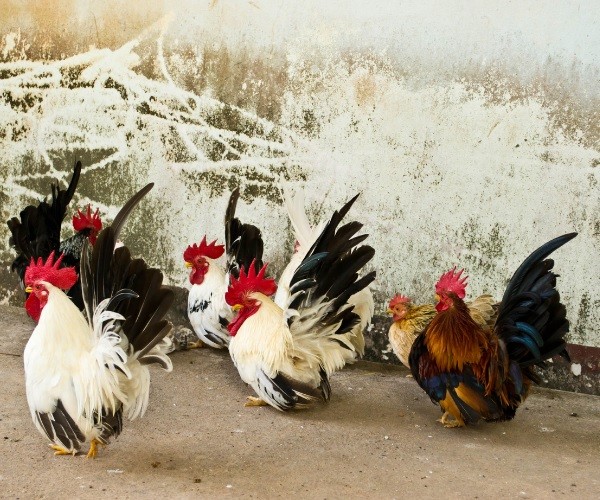
The Japanese Bantam chicken has short, hairless yellow legs. It has a long tail, it carries high, pointed forward, often described as looking like a squirrel; it is held in a dramatic forward way.
In other breeds, this would be a disqualification. This chicken has a U-shaped body. It’s because it holds its wings so low that they actually touch down to the ground. It has a single serrated comb. In the male, the comb is pretty large. The ear lobes and face are red.
Because the legs are so short, with a broad body, the bird looks like it waddles. Colours are Black Tailed White, Buff Columbian, Black Tailed Buff, White, Birchen Grey, Black, Silver Grey, Millers Grey, Dark Grey, Mottled Black, Mottled Red, Mottled Blue, Blue, Cuckoo, Lavender, Red, Tri-coloured, Partridge Bred, Wheaten Bred, Blue Red, Brown Red, Silver, Gold Duckwing.
The Japanese Bantam will lay around 75 eggs in a year which are creamy coloured and small. They are beautiful birds with lovely faces, probably the reason the Japanese aristocracy had them gracing their gardens for years on end. They weight around 1.3lbs.
Behavior/Temperament
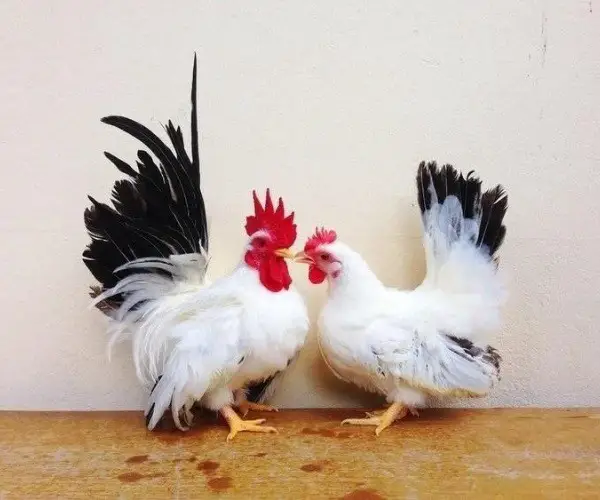
Japanese Bantam Chickens are easy to be tamed, but they are not all that hardy. Quite a good flier. Hens are good mothers. They are easy-going type bids. People usually want these birds simply to add elegance and interest to the yard.
If they don’t have human interaction and attention, they can become a bit flighty. But if given attention they turn out friendly and have plenty of fun. In areas with extreme winter cold, they will need some protection.
What we like and what we don’t like about the Japanese Bantam Chicken:
We Liked
We Don’t Like
Is The Japanese Bantam Chicken A Good Choice For You?
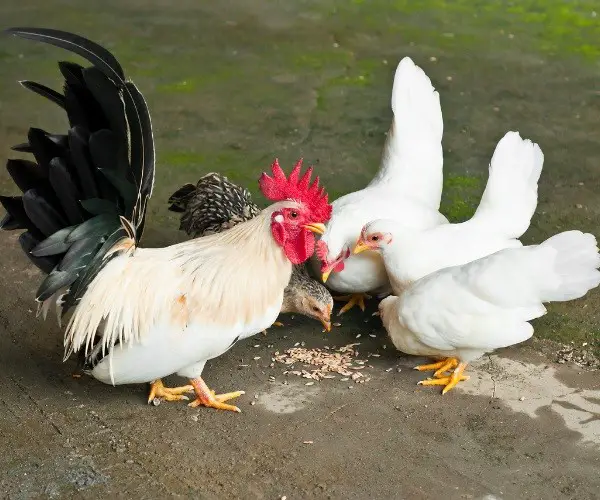
The Japanese Bantam Chicken definitely needs extra consideration and attention and a coop especially to cater to its needs. They are great for the backyard as they don’t do any damage. They contribute much in ornamental-show value.
Because their wings do drag on the ground, they do get discolored and dirty in wet weather. They are birds that even though elegantly beautiful to look at, can be a challenge for the show exhibitor. But in full bloom, they are certainly eye-catching.
If you are looking for Japanese Bantam chickens for sale for egg-laying purposes for their meat, this one won’t be for you – simply, they are beautiful, colourful birds.
Japanese Bantam Chicken Care Guide
The Japanese Bantam is a small chicken breed that originates from, you guessed it, Japan! These birds are friendly and docile, making them wonderful pets. They’re also relatively easy to care for, so they’re a good choice for those new to keeping poultry. If you’re thinking about adding a Japanese Bantam to your flock, here’s what you need to know about their care.
Housing Your Japanese Bantam
Japanese Bantams don’t require a lot of space to be housed in a smaller coop or pen than other chicken breeds. However, it’s important to make sure that their housing is secure, as these birds are good flyers and may be able to escape if given the opportunity. Japanese Bantams also like to roost, so you’ll need to provide them with a perch or two in their coop.
Feeding Your Japanese Bantam
Like all chickens, Japanese Bantams need a diet that consists of quality chicken feed and plenty of fresh water. You can also supplement their diet with scratch grains, chopped vegetables, and other healthy treats.
Exercise and Play
Japanese Bantams enjoy free-ranging, but they do best when they have a safe place to retreat to if they feel threatened. These birds are not as hardy as some other chicken breeds, so providing them with a secure enclosure is important. Japanese Bantams are also known for being good flyers, so you’ll need to ensure their enclosure is well-secured to prevent them from escaping.
Health and Safety
As with all chickens, there are some health concerns that you should be aware of with Japanese Bantams. These birds are susceptible to respiratory illnesses, so keeping their housing clean and dry is important. You should also watch for signs of parasites, such as excessive scratching or weight loss. If you have any concerns about your chicken’s health, consult a veterinarian who is familiar with poultry.
FAQ: Japanese Bantam Chicken
Are Japanese bantams good pets?
Japanese bantams make great pets! They are known for being very friendly and docile, making wonderful companions. Japanese bantams are also relatively easy to care for, making them a good choice for those new to keeping poultry. So, if you’re looking for a pet that will bring you joy and companionship, a Japanese bantam is a great option.
Can Japanese bantams free range?
Japanese bantams can free-range, but they do best when they have a safe place to retreat if they feel threatened. They are not as hardy as some other breeds of poultry, so it’s important to provide them with a secure enclosure where they can feel safe and protected. Japanese bantams are also known for being good flyers, so you’ll need to ensure their enclosure is well-secured to prevent them from escaping.
Can Japanese Bantams fly?
Yes, Japanese bantams can fly. However, they are known for being good flyers, so you’ll need to ensure their enclosure is well-secured to prevent them from escaping. Japanese bantams are also relatively small, so they may be able to squeeze through small openings in fences or other enclosures. If you’re concerned about your Japanese bantams getting out, it’s best to keep them in a covered enclosure or pen.
Do Japanese Bantams like to be handled?
Japanese bantams generally enjoy being handled and often perch on their caretakers’ shoulders or heads. They are known for being very friendly and docile, making wonderful companions. If you’re looking for a pet that will enjoy being held and cuddled, a Japanese bantam is a great option.
Final Verdict: Japanese Bantam Chicken
The Japanese Bantam Chicken is a great pet for those looking for a friendly and docile bird that is easy to care for. These birds don’t require a lot of space, but they do need a secure enclosure to prevent them from escaping. Japanese Bantams also enjoy free-ranging, but they should have a safe place to retreat if they feel threatened. Overall, these birds make great pets for those looking for a low-maintenance chicken breed.

